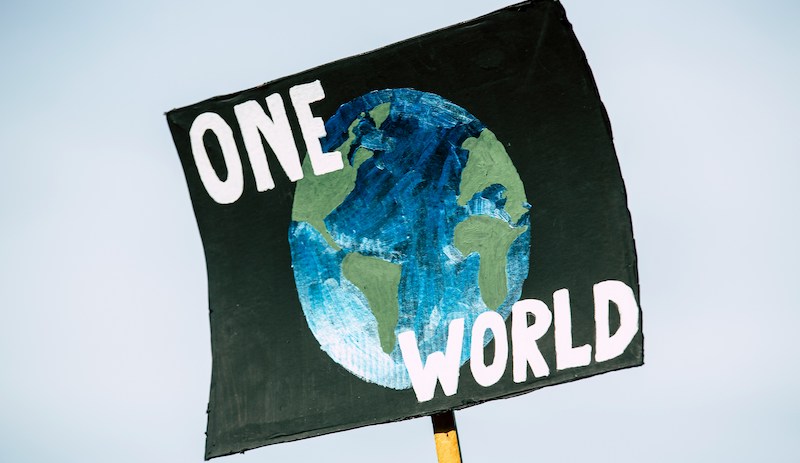Université Toulouse Capitole LLM student Sean Doig shines a spotlight on climate refugees

Rewind back to 1985. New wave music is flooding the charts. Marty McFly is travelling back in time to the night of that terrible thunderstorm. A rising sea of people gathered under the July sun to witness the historical “Live Aid” concert to raise funds for famine-stricken Ethiopia, Sudan, and other African nations. But in amongst the tsunami of highlights from that year is a publication by Essam El-Hinnawi, an expert from the United Nations Environment Programme, that would start the avalanche of discussion around a critical topic for years to come.
It was this publication that first coined the term ‘environmental refugee’ to describe the “increasing large-scale migration and cross-border mass movements of people” that were partly due to weather-related disasters. Since then, weather-related crises have triggered more than “twice as much displacement as conflict and violence in the last decade”, according to the UN Refugee Agency (UNCHR). Indeed, reports from the Environmental Justice Foundation stress that weather-related extremes have caused 21.5 million displacements each year between 2008 and 2016 – that is 41 people every single minute. Those countries that are vulnerable and least developed contribute merely 1% of global emissions, yet suffer 99% of the deaths related to climate and weather-related disasters.
The reality is that no country is safe from climate impacts. From rising sea levels endangering Bangladesh, to the uninsurable Hollywood mansions threatened by wildfires; climate change does not discriminate. The fight to avoid further catastrophe undoubtedly requires international cooperation and must unite the international community.
Still, 28 Conference of the Parties (COP) on climate change later — and almost 40 years since El-Hinnawi’s publication — climate refugees simply do not exist under international law. There is no clear definition of what a ‘climate refugee’ is, and despite climate migration being a recurrent topic in international negotiations, thus far, no official status or legal protection has been granted to those affected. The lack of a legal definition for persons forced to move for climate-related reasons leaves those individuals’ need for humanitarian protection exposed.
While most people who have been forcibly displaced for climate-related reasons remain within their national borders (internally displaced), some are often externally displaced to other countries. Those who leave their countries in the context of climate change or disasters do not qualify for protection under international law.
One of the fundamental reasons given for the lack of international protection is the complexity of defining a ‘climate refugee’. El-Hinnawi’s original definition of an ‘environmental refugee’ is often attributed to a ‘climate refugee’, however the confusion as to whether there is a practical difference between ‘environmental’ and ‘climate’ remains unclear. Despite this hurdle, the challenge in securing protection for those affected by displacement due to climate change involves navigating a way to distinguish them from those ‘Convention refugees’ defined by the 1951 Refugee Convention.
Want to write for the Legal Cheek Journal?
Find out moreIndeed, the granting of ‘refugee’ status to climate migrants was found incorrect by the UNHCR. In 2019, Dina Ionesco, head of the Migration, Environment and Climate Change (MECC) Division at the UN Migration Agency argued that this could weaken the UNHRC 1951 Refugee Convention, and further exclude support to climate-displaced persons unable to give a suitable proof that their forced displacement is due to climate.
The question, therefore, is whether climate refugees should be the subject of a new treaty or convention. The UNHCR argues that those displaced as a result of environmental change could, theoretically, rely on protection granted by their countries where internal displacement occurs. In contrast, traditional refugees cannot rely on this protection as countries are frequently the source of persecution of which the individual is fleeing. Therefore, the individual is “unwilling to avail himself of the protection of that country” as required by Article 1A(2) of the 1951 Refugee Convention. However, the reality is much bleaker for climate migrants, as certain regions are affected by recurrent climate disasters, disrupting both reconstruction efforts and the return of the displaced individuals.
In fact, what if the country loses its statehood entirely due to climate change? The Pacific Island country of Tuvalu is dealing with this question today. The country is facing the threat of disappearing entirely by the end of the century; the sea level being 15cm higher than it was 30 years ago. As Tuvalu steadily vanishes, its people are fleeing, and its government fears it may lose its statehood. In an attempt to ‘future-proof’ its sovereignty and preserve its cultural identity, Tuvalu’s government is creating a virtual country; offering digital passports, and transferring government activities – including elections – to the cloud.
According to international law, a country is required to have a physical territory and a permanent population. But it is not clear what happens if climate change strips a state of those qualities. In 2023, Tuvalu amended its constitution to assert that the country will exist “in perpetuity”, and that its maritime borders will endure even if its landmass disappears. Thus far, the new wording has only been recognised by 12 countries, but the progress is stalled, and it seems unlikely to improve. Tuvalu hopes that if other countries follow its example, international law could evolve.
Despite climate change’s clear and present danger, the people of Tuvalu will struggle to qualify for refugee status and stand to lose out on international protection they will inevitably require. Their pleading for industrialised countries to lower emissions in the past three decades have long been ignored, and the impact is sinking in.
The landmark Teitiota case in 2015 corroborates the urgent need for a broad, universal definition of a climate refugee. Teitiota was seeking refugee status in New Zealand for himself and on behalf of his family due to the threat of submergence of Kiribati Island caused by climate change. Two years after Teitiota applied for asylum based on the forced displacement caused by climate change, the New Zealand Supreme Court rejected his application on the basis that he did not fall under the scope of the Convention’s definition of a refugee. Although the judgement did not favour Teitiota and his family, the ruling opened the way for other claims on the threat to life caused by climate change. Judge Priestly stressed the idea that the legal definition of ‘refugee’ is not limited to that given by the Convention, but has the ability to be expanded and defined as “a person driven from his or her home to seek refuge, especially in a foreign country, from war, religious persecution, political troubles, natural disaster, etc.”
Subsequently, Teitiota’s father filed a complaint with the UNHCR, causing a statement to be issued acknowledging that rising sea-levels are threatening life and refugee law must be broadened to accommodate this. Indeed, the UN Human Rights Committee declared it unlawful to return individuals back to countries where their lives may be threatened by the effects of climate change, providing hope for climate refugees’ protection.
To expressly define a “climate refugee”, a new protocol should be adopted to the Convention under the mandate of the UNHCR providing a broad, universal definition preserving their rights and taking into consideration the temporary and permanent nature of their displacement. There are climate refugees who will not be in a position to return to their country of origin – particularly where small islands will be submerged, such as Kiribati or Tuvalu – therefore, climate refugees should benefit from permanent protections without fear of persecution. Further, those permanent climate refugees should “receive fundamental civilian freedoms and human rights necessities without socio-political persecution”, permitting successful integration into the host country.
The definition should also recognise internally and externally displaced persons, both with equal rights and opportunities in the receiving country as individuals with refugee status under international law. Finally, the definition should recognise that climate refugees should be understood as having a “well-founded fear” of the consequences that climate change may have on their livelihoods. Such a loss of livelihood could provoke a fear of life or death, the same criteria for evidence of persecution in the Convention definition of refugees.
Even in countries where climate change has less impact in a physical sense, the urgency and responsibility to act cannot be ignored. The Scottish government recently proved that the neglect of crucial climate targets can cripple a government to its knees.
With the number of ‘climate refugees’ steadily rising each year, it is imperative that the international community acts in a unified manner to ensure the legal recognition and protection of those vulnerable individuals displaced by climate change. Instead of more shallow climate pledges, it is time to focus on safeguarding the rights of climate migrants and getting ahead of the curve. Ultimately, international law must fool-proof itself from climate-denying governments and U-turning states, upholding the value of the rule of law for the people it serves.
Sean Doig is an LLM student at Université Toulouse Capitole specialising in International Economic Law. He is currently working on his master’s thesis, and displays a particular interest in international law, technology and dispute resolution.



